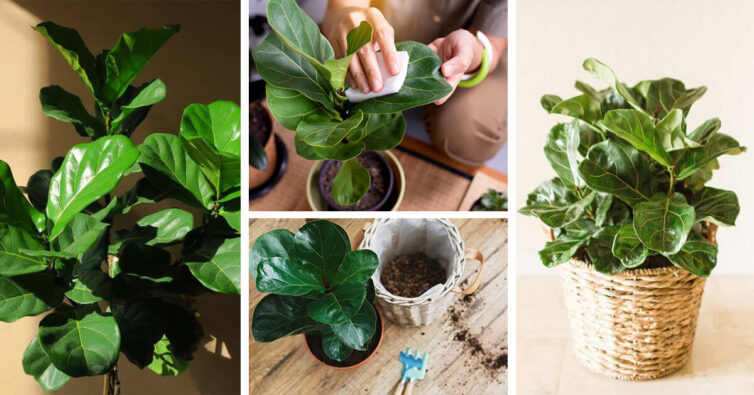It would appear that the Fiddle-Leaf Fig has become a member of the elite trendy indoor plants. Pick up any home decor magazine, and one of these trees will be hiding somewhere in a plan’s landscape.
If you’re looking for a bold statement that brings sculptural variety to your indoor garden, the Fiddle-Leaf fits the bill perfectly. It isn’t stuck in any particular style motif. Add it to a shabby chic room, a bohemian concept, or art deco, for example. Fiddle-Leaf figs are unassuming, blending into your space without overcoming your other plants.
There’s a reason for Fiddle-Leaf Fig’s popularity. The exquisite large green leaves make it a lovely centerpiece. They feel welcoming near the door and can fill an awkward nook that’s been bare because you couldn’t figure out what to put there. They can grow up to 6 feet tall, filling out a space with grandeur.
Home Bodies: Just like folks who love to stay at home, your fiddle-leaf fig wants to stay put. Moving it from the store to your home may create shock, and you don’t want to add to the condition. Place it into the pot you’ve chosen, set it where it will “live” and leave it be. The only movement is turning the plant ¼ once a month so it receives even sunlight on all sides.
Figuring out Fiddle-Leaf Fig Care
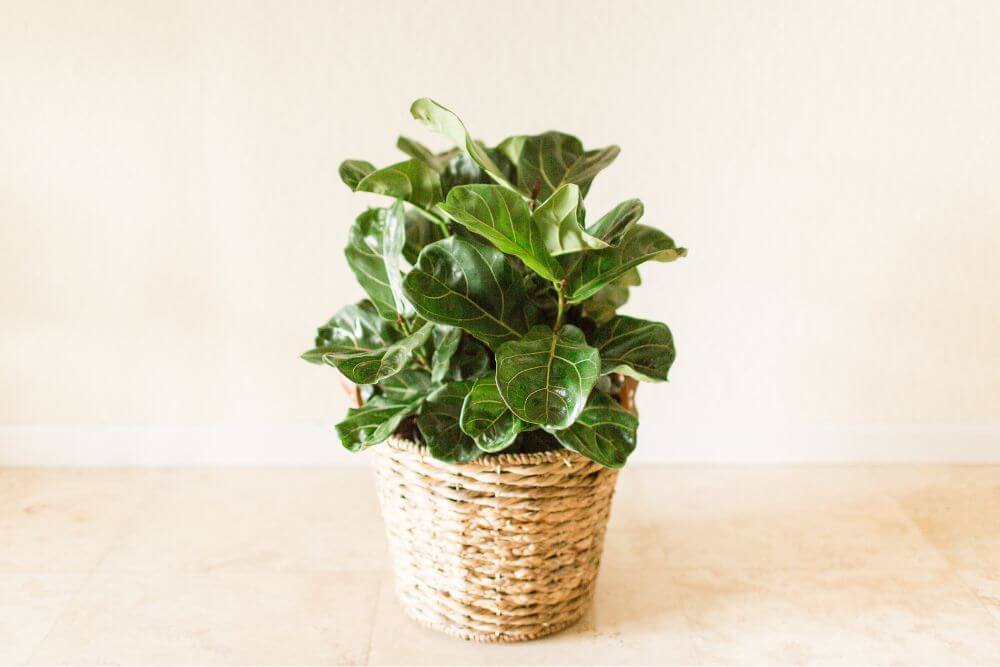
Step one in caring for your fiddle-leaf is finding the best spot for it, where it will thrive. As a tropical plant, keep it away from air conditioner ducts or drafty windows. Additionally, your fig needs a LOT of bright, indirect light. If you water them about once a week, they’ll reward your care with flourishing growth.
Speaking of plant pots, look for one with adequate drainage. One hole really isn’t enough for plants susceptible to root rot. Consider finding a self-watering system that will keep the soil moderately moist.
Fiddles are creatures of habit and will flourish once they’ve found a happy, sunny home. Once a week, when you water, turn the plant slightly so that the leaves receive equal sunlight and don’t start to grow toward a light source.
Something helpful to the Fiddle-Leaf is a quarterly dusting. Use some room temperature water, a soft microfiber cloth, and free the leaves of dirt so they can process sunlight efficiently. It also gives them a pretty sheen.
The most important part of fiddle-leaf care is watering. People often over or under water. This plant prefers moist soil, not wet. Let the soil dry briefly between waterings. Since conditions in your home don’t change dramatically often, you can get to know your fiddle-leaf’s biorhythm and create a routine for its care.
If you’ve heard that there are plants that contribute to clean air, it’s not a myth. NASA reports that fiddle-leaf figs remove chemicals from the air, like ammonia, benzene, and formaldehyde. This plant also produces oxygen. The larger the plant, the better results. Enjoy your fiddle-leaf fig, and take a deep breath of fresh air.
Fiddle-Leaf Fig Needs
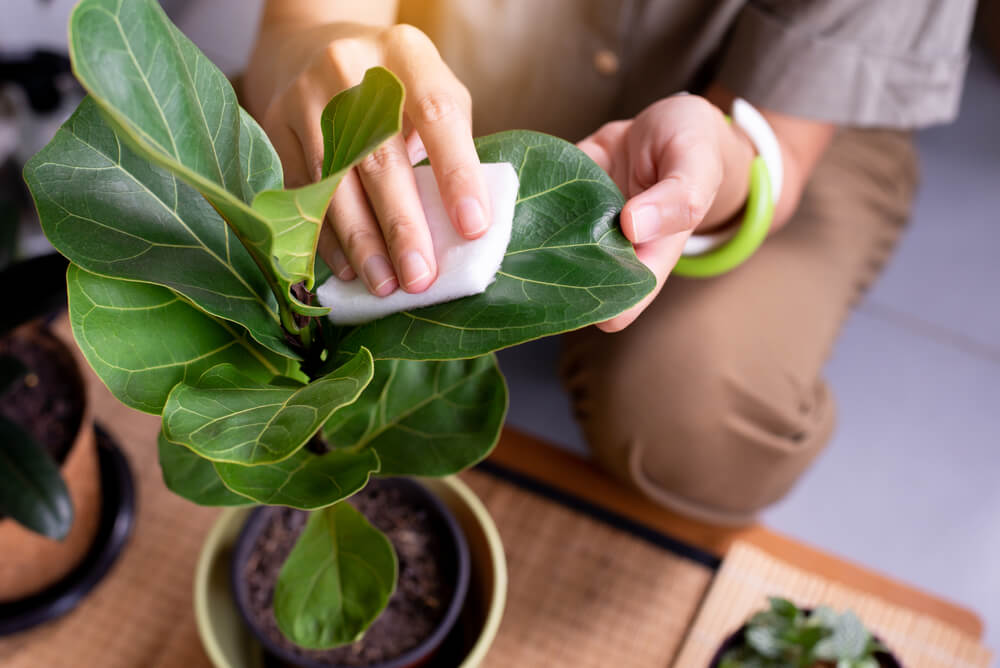
All plants have specific needs that have to be fulfilled to keep them healthy.
- Fertilization: There are actually fertilizers blended specifically for the fiddle-leaf fig. Feed the plant three times in summer (monthly) and once in spring.
- Humidity: In the rainforest, the humidity level averages roughly 84%. Your home is not that humid. To help, mist your Fiddle-Leaf regularly. If you have a humidifier, put it near the plant.
- Light: Being tropical plants, they prefer warm, bright indirect light. While they have full sun in the wild, come afternoon, trees protect them from the blistering sun. With this in mind, a southeast or southwest window is a good choice. The plant will get sun all day but not the brunt of noon-time sunshine. Make sure your fiddle-leaf gets 6 hours of light daily.
- Soil: Get peat-based soil with perlite. Mix that with ⅓ to ½ cactus potting mix. This results in the soil draining better and receiving aeration.
- Water: Get a pot for your fiddle leaf fig with several drainage holes. When water collects in the bottom of a container, it can lead to root rot. If your planter has a saucer, empty it regularly. If your plant’s leaves become limp and look sad, it’s not getting enough water. When the leaves have yellow-bordered brown spots, your plant is getting too much water.
Fiddle-Leaf Fig Fruit: While the fiddle-leaf rarely fruits indoors, the outdoor plant may produce small, fig-like fruit. They’re not quite like typical figs. They don’t taste very good in part due to leathery skin and tartness.
Fiddle-Leaf Figs for Your Home
When purchasing a fiddle-leaf fig, give it a once over. Look for signs of bugs on the underside of the leaves. Check the stems for compact growth and good leaf density. Speaking of leaves, they should not have any brown edges, yellowing, and point upward.
If you live in an area that gets cold, try to buy your plant on a day that’s over 50 F. Fiddle-leaf figs don’t like the cold. It causes them stress.
Potential Plants
- Audrey: This is the national tree of India. If you have a busy life, the Audry plant is kind of calm and cool. City dwellers in apartments with filtered life are fine with these plants. They add grace and a touch of elegance wherever you put them.
- Bambino: Oblong-shaped leaves. Perfect for small spaces and as a beginner’s plant. They remain compact and bushy, only growing to 3 feet tall.
- Benjamina: The Benjamina goes by the nickname of “weeping fig.” If you conjure the image of a fiddle-leaf fig, it is probably the Benjamina because it is among the most popular indoor ficuses. The leaves are oval, so if you trim it properly, you can create a lolly pop. Or you can braid it.
- Compacta: This is a slow-growth fiddle leaf. Indoors it grows to about 5 feet with bunched, smaller leaves.
- Suncoast: Despite the warm name, Suncoast is more cold-tolerant than many other fiddle-leaf figs. It bears broad, oval-shaped leaves, looking quite ornamental.
- Umbrellata: It is a striking plant with glossy, emerald-green, heart-shaped leaves. It goes by the nickname “elephant ear fiddle leaf,” one look explains the moniker. These grow to feet tall.
- Variegated: A pleasant change of pace. This fiddle head’s leaves have creamy yellow edges and spots of both light green and dark green.
- Warning: this is toxic to pets.
Feng Shui considers the soft, round leaves as bearing nourishing and nurturing energy. If there’s a place that feels dark and gloomy, the presence of the Fiddle-leaf attracts positive energy. Additionally, fiddle-leaf represents good fortune. To attract wealth, put it in the southeast area of your home. To focus on your career, set it up in the north. The fruit of this plant symbolizes fertility, family love, and marriage when placed in the east or southwest of your home, respectively.
Watering techniques For Indoor Fiddle-Leaf Figs
Experienced Gardens will tell you that the number one reason for problems with the fiddle-leaf is over-watering. When the roots of this plant get soddy, root rot ensues. As a basic rule, water this plant every 10 days. Because the fiddle-head is native to the rainforest, it’s natural for them to respond positively, getting a soaking followed by a dry spell. You want to maintain that pattern.
Put the plant into your sink or tub on a drip tray. Slowly add water until the water comes out the bottom. Leave it in the sink for a while so you’re not dribbling when you place it back in its location.
Keep Me Clean: Over time, dust and dirt accumulate on fiddle-leaf figs leaves. This impedes the healthy integration of sunshine. So, when you water the fiddle-leaf, take a moment to wipe off its leaves. It deters yellowing and browning.
Potting and Repotting Fiddle-Leaf Fig
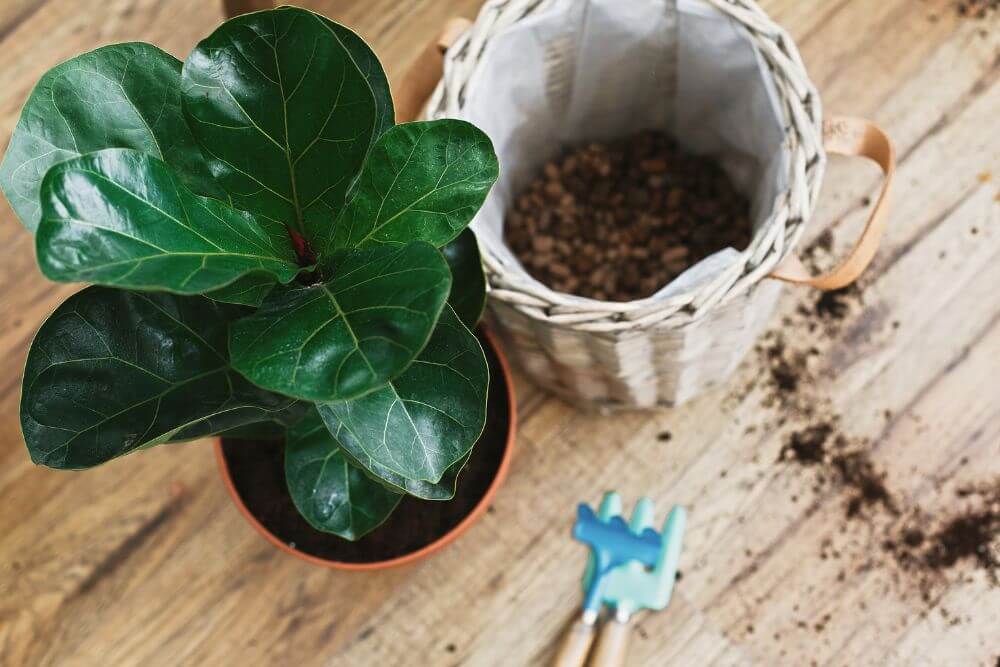
You’ll find that potting and repotting are basically alike. When you first bring your plant home, transfer it into a pot of your choosing (with several drainage holes). You can fill it with potting soil or fiddle-leaf fig soil.
Gently pull the fiddle-leaf fig out of the garden center container. Check the roots, gently cutting away anything that’s mushy or dead. Put the plant into its new home and give it a good watering. Start following your watering routine now.
On average, your fiddle-leaf fig needs repotting every 2-3 years. If you notice the roots poking out of the bottom of the planter before then, it’s time to replant. Choose a new crock that’s 2 inches wider than the original, and put a few rocks in the bottom to help with humidity. Fill it halfway with fresh soil. Make a little crater in the center of the soil.
Put the root ball in that little crater, then surround the bottom of the plant with more soil. Stop when you reach 1 inch below the container’s rim.
In 2016, the New York Times named the fiddle-leaf fig the “it” plant of the design world. Its appearance in commercials, movies, and TV, not to mention its ever-growing popularity among consumers, supports that choice. Since then, it’s remained in the limelight.
Fiddle-Leaf Fig Pruning and Maintenance
In your travels, you’ve probably seen two types of fiddle-leaf figs. One has a bare trunk and looks much like a tree, and another that’s bushy. If you want to shape your plant, do so in the spring. That gives the fiddle-leaf energy for regrowth.
When leaves become significantly brown, remove them. Cut them about a half inch away from the trunk. Don’t take more than 1o leaves at a time or you may cause stress in the plant.
Name Me: Common nicknames for the fiddle-leaf fig include banjo fig, fiddle-leaved fig, and lyre-leaf fig. By the way, the species epithet “lyrata” is a Latin word for lyre based on the plant’s leaf shape.
Fiddle-Leaf Fig Blooming and Resting Periods
Plants are connected to the change in the seasons. The changes in sunlight and temperature mean you need to make slight modifications to your fiddle-leaf fig. During winter, they will not grow as quickly, so they won’t require as much water or fertilizer. Continue making sure your plant gets enough sunlight.
If you need to move your plant to a sunnier area, do so slowly. Sneak it over about 1” every two days. It needs an adjustment period.
During this period, your plant will lose leaves. It’s wholly natural. In particular, they drop lower leaves. The only time you should worry is when leaves drop rapidly. Then it’s time to check for pests and diseases.
A Good Night’s Sleep: Fiddle-leaf figs produce oxygen. They can increase the amount of oxygen in your whole home. In turn, you may sleep better. During the day, your houseplant may improve your ability to focus and recall.
Common Pests & Plant Diseases of Fiddle-Leaf Figs
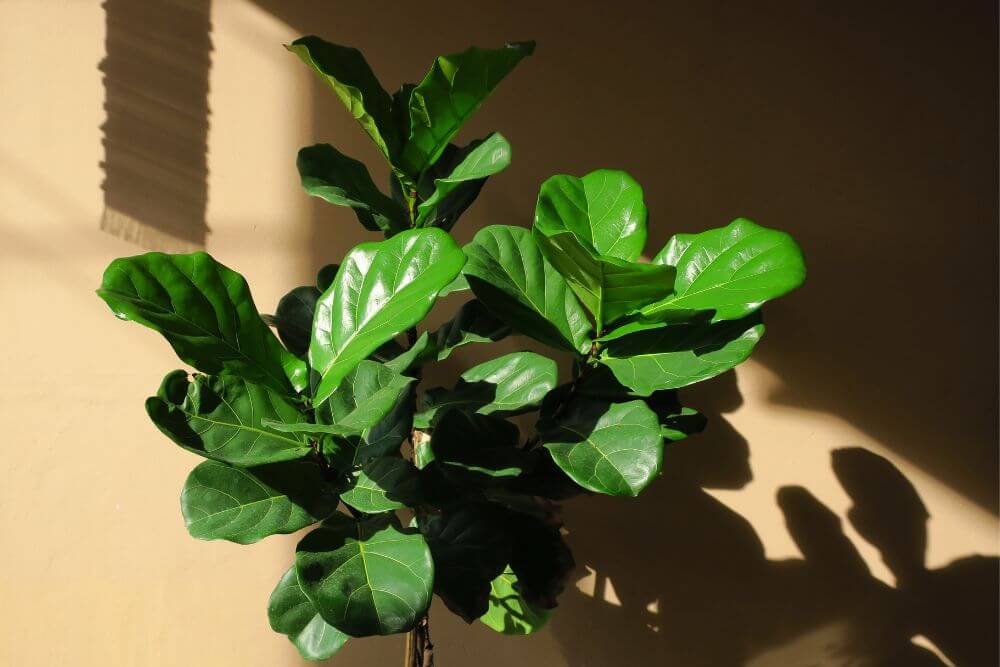
The fiddle-leaf fig is a hardy fellow. Even so, it may experience insects or disease. When you know what to look for, you can start treating the problem before it’s beyond all hope.
Critters
- Fungus gnats: While you see them flying, their eggs are in the soil. You can try changing out the soil.
- Mealybugs: Common among indoor plants, these guys love sap. As they eat, they leave a sticky trail on the leaves. If the sticky substance remains too long, the fiddle-leaf may develop mold.
- Red Spider Mites: these are sap eaters. They go on their merry way, having created mottled leaves. These insects are very active in summer. If you plan on giving your fiddle-leaf a romp in the sun, keep this in mind.
- Spider mites: start their invasion at the young, top leaves. When these are sound, the plant leaves develop holes, and there are little webs in their wake. Just spray your plant daily to knock off the mites. Continue for several weeks since eggs may be left behind.
- Thrips: another sapsucker who damages leaves in its wake. Discovered leaves are one sign. Try pesticide.
Disease
When your fiddle-leaf fig manifests droopy leaves, yellowing shriveling, brown spots, and stunted growth, your plant may be sick.
Tiny red or brown dots on new growth is Edema. It happens when the water schedule isn’t consistent. This won’t hurt the plant unless you don’t adjust when you apply water. Consider investing in a moisture meter.
Dark brown or black spots appearing on lower leaves may indicate root rot. Stems may be mushy too, and the plant smells nasty. If root rot seems to be new, you can remove those leaves and let the plant dry out. Move your fiddle-leaf into more light. If the condition progresses, remove the plant, trim out sick roots, and repot in fresh soil.
In order to propagate a fiddle-leaf fig, you need a cutting from the tip with 6 inches of stem cut on an angle. Dip the bottom in rooting hormone. Moisten the soil, then create a small hole to nestle the cutting. Tuck in your soon-to-be baby fiddle-leaf into the soil. Put it in bright, indirect light. Roots should form in 6 weeks.
Troubleshooting Common Fiddle-Leaf Fig Problems
When the edges of your fiddle-leaf fig brown, it indicates over-watering. Brown spots reveal under-watering. So adjust your watering schedule and stick with it.
Brown spots could also result if your plant gets too much direct sun or that it had cold exposure. Fixing this is pretty easy (move the plant) but be patient. It takes a while for plants to bounce back.
Drooping yellow leaves = over watering. Crispy leaves = under watering or too much direct sunlight. Curling leaves = low humidity, root disturbance, over watering or under watering.
Keep things Humid: Most indoor humidity levels are around 10%, including in your home. Meanwhile, the fiddle-leaf fig prefers 65% humidity. One way to help your plant is by keeping it near an indoor humidifier. Add a weekly spritz of warm water, and you’ll notice a difference in the plant’s perkiness.
[wp-faq-schema title=”Frequently Asked Questions About Indoor Fiddle-Leaf Fig Care” accordion=1]
